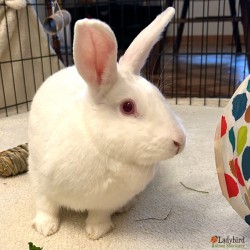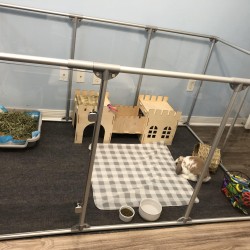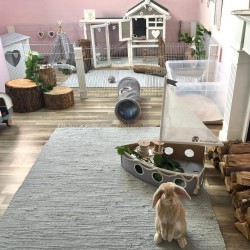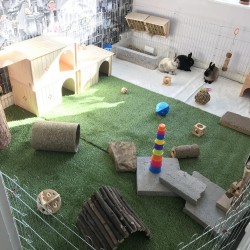Rabbit Care
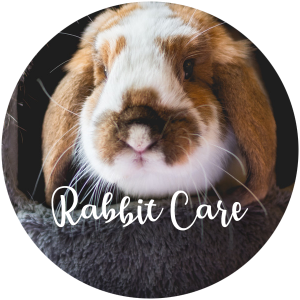
Your Guide to Caring for Rabbits
- Aspen
- Calla @ foster
- Prue
Are you thinking about adding a fluffy rabbit (or even two!) to your family? Rabbits are super popular as pets, but it’s important to know that they have their own unique needs and behaviors that are different from cats and dogs. Before you hop into bringing a rabbit home, let’s dive into what it’s like to live with these adorable furry friends.
Rabbits are long-term pals, so be ready to dedicate time every single day for up to 15 years to take care of them. This includes feeding them, cleaning up after them, and spending quality time together. Rabbits truly become part of the family, so it’s awesome if you can set up their living space in an area where you and your loved ones hang out. A spacious enclosure or giving them free rein in a whole room is ideal. Rabbits have behaviors that resemble their wild relatives, and two things matter a lot to them: feeling safe and having a companion.
When it comes to safety, rabbits are prey animals by nature. Just like in the wild, they might freeze or scamper away when they get scared. To help them feel secure, make sure they have a cozy shelter where they can retreat to, whether it’s inside their enclosure or while they’re exploring the room.
Companionship is also vital for rabbits. In the wild, they live in big groups, looking out for each other, munching together, and even giving grooming sessions. That’s why considering adopting more than one rabbit can be a fantastic idea. They’ll keep each other company when you’re not around, and it’ll bring them lots of happiness.
Oh, and here’s a fun fact: rabbits have their own personalities! Some may start off a bit shy and take some extra time to relax and get comfortable in your home. But once they warm up to you, they can become the most delightful and affectionate pets you can imagine. Building a lifelong bond with your new fluffy companion will require commitment, patience, and a deep understanding of rabbit behavior. Trust us, it’s totally worth it!
FOOD AND DIET
- Moe – photo by Luca Simpson
- Jackson – photo by Luca Simpson
- Tyson @ foster
Are you ready to learn about what makes a balanced diet for rabbits? They enjoy a variety of hay, fresh greens, a bit of fruit, and quality pellets.
First, let’s talk about hay. It’s like their superfood! Make sure to offer unlimited amounts of fresh hay every day. Rabbits prefer mixed grass hay or Timothy hay because they’re lower in calories and calcium compared to alfalfa. Opt for high-quality, fiber-rich pellets made from alfalfa or Timothy hay. Our recommendation? The Oxbow brand. They’re top-notch!
When it comes to veggies, rabbits are the real connoisseurs. They need at least 1 cup of vegetables for every 4 lbs. of their body weight. Aim for a daily selection of three different veggies to ensure they get all the necessary nutrients. It’s important to have variety, so make sure to include one veggie each day that contains Vitamin A (look for the asterisk symbol*). Start by introducing one vegetable at a time, gradually adding more. If you notice soft stools or diarrhea, remove that particular veggie from their menu.
Now, let’s talk fruity treats! Limit fruits to 1-2 tablespoons per 5 lbs. of body weight (or none if your rabbit is on a diet). We’ve got a list of high-fiber fruits they’ll enjoy. But remember, sugary fruits like bananas and grapes should be used sparingly as occasional treats. Bunnies have a sweet tooth, and if given the chance, they’ll happily munch on sugary foods instead of the healthy ones.
Here are some rabbit-friendly veggies and fruits to choose from:
Vegetables:
- Alfalfa, radish & clover sprouts
- Basil
- Beet greens (tops)*
- Bok choy
- Broccoli (mostly leaves/stems)*
- Brussels sprouts
- Carrot & carrot tops*
- Celery
- Cilantro
- Clover
- Collard greens*
- Dandelion greens and flowers (pesticide-free)*
- Endive*
- Escarole
- Green peppers
- Kale*
- Lettuce: Romaine, Red or Green leaf (no iceberg or light-colored leaf)*
- Mint
- Mustard greens*
- Parsley*
- Pea pods (the flat edible kind)*
- Peppermint leaves
- Radicchio
- Radish tops
- Raspberry leaves
- Spinach*
- Watercress*
- Wheatgrass
Fruits:
- Apple
- Blueberries
- Melon
- Orange (including peel)
- Papaya
- Peach
- Pear
- Pineapple
- Plums
- Raspberries
- Strawberries
Now, one important note: absolutely NO chocolate (it’s poisonous!), cookies, crackers, breakfast cereals, bread, pasta, yogurt drops, or other “human treats.” Research suggests that these items may contribute to fatal cases of enterotoxemia, which is a toxic overgrowth of “bad” bacteria in the intestinal tract. Let’s keep our furry friends safe and healthy!
Remember, providing a balanced and nutritious diet is a sure way to keep your rabbit hopping with joy!
For treats, we recommend Oxbow brand’s line of Simple Rewards treats, and hand made treats and chew toys by companies like Tiny Paws Emporium, Green Bunny Store and Professor Flop’s Bunny Shop
HOUSING
- Rabbit enclosure
- Rabbit enclosure
- Rabbit enclosure
DOES MY RABBIT NEED A CAGE?
Your rabbit doesn’t need to be confined to a cage. However, it’s advisable to provide an area for your rabbit to call home when you’re not around or at night. This can be an exercise pen (x-pen), or keeping them in a rabbit proofed spare room.
Rabbits are crepuscular creatures, which means they tend to sleep during the day and night but are full of energy during dawn and twilight. It’s important to let them out to play in the evenings when you’re at home and, if possible, in the mornings while you prepare for work.
Once your rabbit becomes familiar with your home, you understand its habits, and your house has been properly bunny proofed, there’s no reason why they can’t have the freedom to roam your home even when you’re not there. It’s all about creating a safe and comfortable environment for your furry friend.
- Clear rabbit enclosure
- Rabbit Room
- Rabbit Room
WHAT SIZE HOUSING IS BEST?
Think big and give your bunny room to roam! When it comes to your rabbit’s living space, remember that bigger is always better. Provide your furry friend with a home that is at least 4-6 times the size of their fully stretched-out body. If your rabbit spends a lot of time in their enclosure, it’s even better to give them more space. Take into account the exercise time and freedom your rabbit needs to hop around happily.
As a general rule, aim for a minimum of 8 square feet of enclosure space, along with a spacious exercise area of at least 24 square feet. This setup is perfect for 1-2 rabbits, allowing them to run, play, and explore for a minimum of 5 hours each day. Remember, these little fluffballs love stretching their legs and having plenty of room to hop to their heart’s content!
CAN MY NEW BUNNY HAVE FREEDOM 24/7?
Once your rabbit has become familiar with your home, you understand their behavior, and your house is fully bunny-proofed, there’s no reason why they can’t have the run of the house even when you’re away.
HOW CAN I MAKE MY RABBIT’S ENCLOSURE TIME MORE ENJOYABLE?
Think of your rabbit’s enclosure as their cozy nest—a special place where they feel safe and secure. Make their nest enjoyable, and they’ll love spending time there, even when the door is open! Fill it with toys, soft blankets, and when you tuck them in at night, offer a tasty veggie or fruit snack. If your rabbit has an x-pen, consider adding a wooden, cardboard, or fabric playhouse for them to climb and hide in. It will make their time in their “home” much more enjoyable. Just make sure not to place the house too close to the side of the pen to prevent your bunny from climbing on top and jumping over.
You can make your own DIY rabbit toys. Another fantastic enrichment option is a dig box.
RABBIT PROOFING
- Veronica-photo by Willow Bean Photography
- Ally – Photo by Willow Bean Photography
- Willow – photo by Willow Bean Photography
Rabbits are incredible creatures, but they do have some behaviors that can be a bit destructive. It’s not uncommon to discover chewed wires or corner-dug carpets thanks to these mischievous little friends. Fortunately, there are tried and true methods to bunny-proof your home. By taking these steps, you can ensure your rabbit’s safety, protect your belongings, and provide them with more productive outlets for their natural instincts.
To effectively bunny-proof your home, it’s important to consider these three aspects: keeping your rabbit safe, safeguarding your belongings, and offering alternative activities that satisfy their instincts. By looking at your home from a rabbit’s perspective, you’ll gain valuable insights into potential dangers or destructive behaviors they may engage in. Get down on your hands and knees to assess the environment and identify areas where your rabbit might find trouble. With a little foresight and preparation, you can prevent wire chewing, carpet digging, and other troublesome acts from taking place.
Rabbit-proofing, also known as bunny-proofing, involves the following steps:
- Preventing destructive behaviors by creating barriers or removing potential hazards.
- Ensuring your rabbit’s safety by eliminating access to dangerous areas.
- Providing enjoyable alternatives for chewing and digging to redirect their energy.
The ultimate goal is to create a space where your rabbit can exercise and roam freely without constant supervision. Depending on your preference, you can choose to rabbit-proof a specific room or even your entire house, giving your furry friend more room to explore and be part of the family. With a little effort and some strategic adjustments, you can create a harmonious living environment where your rabbit can thrive while keeping your home intact.
Check out this video for in depth detail about rabbit proofing.
LITTER TRAINING
- Buddy – photo by Luca Simpson
- Quinny
- Archer
By nature, rabbits have specific spots, usually corners, where they prefer to urinate and do most of their business. Litter-training your rabbit is a simple process that involves providing them with a designated litter box in their chosen spot. Here are some friendly suggestions to help you train your rabbit to use the litter box:
What types of litter should I use?
When choosing litter, consider what’s available in your area and the needs of your rabbit. Keep these points in mind:
- Rabbits spend a lot of time in their litter boxes.
- They may nibble on some of the litter.
- Rabbit urine has a strong odour.
Place a handful of hay in a corner of each litter box. It’s helpful to have several layers of newspaper or litter beneath the hay to absorb urine, preventing your rabbit from standing in it. Most newspapers today use soy-based ink, which is safe for rabbits, but it’s always a good idea to check with your local newspaper first. Remember to change the hay frequently (daily) since your rabbit will be eating it. This method encourages good litter habits and promotes hay consumption, as rabbits often eat and use the litter box simultaneously. Rabbits like to “poo and chew.”
Safe litters:
- Newspaper-based litter (fluffy or pelleted), such as Carefresh, Oxbow Pure Comfort, Yesterday’s News, Fresh4Life, Small Pet Select Soft Paper Bedding, and okocat paper litter.
- Compressed sawdust pellets (kiln-dried only), like wood stove fuel pellets and Feline Pine.
Litters to avoid:
- Pine or cedar (softwood) shavings or chips
- sWheat Scoop Litter
- Clay litter
- Clumping litters
- Corn cob litter
How to litter train:
Most adoptable rabbits are already litter trained when they go to their forever homes, which is helpful. However, some bunnies may need a reminder once they’re in their new environment.
Start by placing a litter box in the enclosure and one or more boxes in the rabbit’s running space. If your rabbit urinates in a corner without a box, move the box to that corner until they understand where to go. Don’t worry if your bunny curls up in their litter box—it’s a natural behavior.
Once your rabbit is using the box in the enclosure, open the door and allow them to access their running space. Observe as they move in and out on their own. If they head to a corner without a box or raise their tail in the characteristic fashion, say “no” in a firm, sharp tone. Gently guide them back to their enclosure and the litter box or one of the boxes in their room.
Be careful not to make the enclosure or litter box feel like a punishment. Placing a handful of hay in the box will make it a more inviting place. After your rabbit uses the box for the first time, praise them and give them their favourite treat.
As your rabbit uses the box in their room a few times, their habits will start to form. Once they are well-trained in their initial space, you can gradually increase their area. Take your time with this process, and if the area becomes larger or includes multiple levels, make sure to provide additional litter boxes to avoid confusion.
As your rabbit gains confidence and starts using fewer boxes, you can remove some of the extra “training” boxes.
Establish a daily routine for your rabbit and try to stick to it. Rabbits thrive on habits, and once a routine is established, they usually prefer to stick with it.
TEETH
Rabbit teeth are truly iconic! When you picture a rabbit, those long ears and big buck teeth immediately come to mind. It’s no wonder that their teeth play a crucial role in their overall health. Just like our fingernails, rabbit teeth continuously grow. However, if they become too long, it can cause eating difficulties and other serious health issues.
Caring for your rabbit’s teeth is essential. One of the best ways to do this is by including timothy hay in their daily diet. Not only does it provide essential nutrients, but the chewing action also helps wear down their teeth naturally. Additionally, offering a variety of chew toys, such as wood, twigs, and cardboard, can keep their teeth in good shape and prevent overgrowth. It’s like a fun dental workout for your furry friend!
By providing your rabbit with the right diet and plenty of chewing opportunities, you’ll ensure their teeth stay healthy, allowing them to enjoy their meals and live a happy, hoppy life.
In addition to taking your rabbit for their yearly vet checkup to keep them in tip-top shape, you can also perform at-home tooth checks to catch any signs of dental disease early on and prevent more serious health issues. While problems with a rabbit’s teeth may initially seem minor, they can actually trigger a chain of other health problems if not properly addressed. One of the most significant red flags to watch out for is a decrease in appetite. However, it’s important to know that overgrown and unhealthy teeth can also lead to infections that may spread to other areas of your bunny’s precious little skull.
By keeping an eye on your rabbit’s dental health and catching any concerns early, you can ensure their overall well-being and happiness. Regular tooth checks, along with proper dental care, will help your furry friend maintain healthy teeth and a joyful appetite. Remember, a healthy smile leads to a happy bunny!
- Banana’s teeth before
- Banana’s teeth before
- Banana’s teeth after first trim
Malocclusion, a condition where a rabbit’s teeth don’t wear down properly, can be a challenge for our furry friends. Since their teeth are constantly growing, misalignment can occur, particularly with the front teeth. In some cases, the back teeth may also be affected. You may notice a wet chin caused by drooling as an indication of misaligned teeth. If this happens, it’s important to seek help from a veterinarian who can trim the teeth regularly, ensuring your rabbit can eat comfortably.
To address malocclusion, veterinary intervention may involve clipping, dremeling, or even removing the teeth if necessary. By keeping a close eye on your rabbit’s dental health and promptly addressing any misalignment issues, you’re helping them enjoy their meals without discomfort. Remember, your veterinarian is there to assist and provide the necessary care to keep your rabbit’s teeth in great shape.
MEDICAL CONCERNS
- Ruby @ vet
- Buttons @ vet
- Aspen @ vet
Because rabbits are prey animals, they have a unique ability to hide their symptoms when they’re not feeling well. It’s crucial for you to pay close attention to their behaviour and personality, as even slight changes can indicate illness. Let’s explore some medical issues that you should be aware of when living with a house rabbit.
GI Stasis/Not Eating
One very serious, fairly common health issue pet rabbits face is gastrointestinal stasis. GI (or gut) stasis is a potentially deadly condition in which the digestive system slows down or stops completely.
If your rabbit is demonstrating any of these symptoms of GI stasis, bring him/her to a rabbit-savvy vet immediately:
Rabbit Hemorrhagic Disease (RHDV)
Rabbit Hemorrhagic Disease is a highly contagious and fatal disease. This deadly calicivirus affects both wild and domesticated rabbits. It kills quickly and with little warning. A safe and effective RHDV2 vaccine is available. We strongly recommend that all rabbit owners vaccinate their bunnies against this disease.
Find out more about RHDV
Bacterial Infections
An infection may manifest as a runny nose, eye discharge, high temperature, rattling sound from the lungs, or occasionally a cough. It’s crucial to seek veterinary assistance as soon as you notice the first symptoms of an infection. Early detection improves the chances of successful treatment. One commonly mentioned bacteria is Pasteurella, which can often be eliminated or controlled with newer antibiotics. It’s important to have your veterinarian perform a culture to determine the specific bacteria being treated.
Red Urine
Rabbits’ urine can vary in colour from clear to yellow to brown to bright red. In most cases, this isn’t cause for immediate alarm unless accompanied by other signs such as straining to urinate, loss of appetite, or changes in body temperature. If you notice red urine, stay vigilant for additional signs that may indicate a problem. If in doubt, consult your veterinarian to test for the presence of blood.
Diarrhea
Though not common in house rabbits, diarrhea can occur, leading to dehydration. It’s crucial to get them to a veterinarian promptly as dehydration is a threat to a rabbit’s survival.
Abscesses
If you find a lump under your rabbit’s skin or jaw or any unusual swelling near/under their eye, it may be an abscess caused by a bacterial infection. While treatable, abscesses require immediate attention from a veterinarian.
By staying vigilant and proactive, you can ensure your furry friend receives the best possible care and stays healthy and happy. Remember to always seek professional veterinary advice when in doubt or when dealing with any health issues in your rabbit.
FINDING A RABBIT SAVVY VETERINARIAN
Not every veterinary clinic offers specialized care for small animals like rabbits. Rabbits require a vet who has the expertise to properly treat “exotic” pets to give them the best care possible.
Rabbit adopters should already have a vet picked out who has the knowledge to care for their new friend – be it for a general health check, or an emergency.
We’ve compiled a list of vets in the Hamilton and surrounding area that we have either used ourselves, or confirmed that the clinic has a vet on staff who is trained in small animal care.
BONDING RABBITS
- Louise and Thelma
- Marvin & Moby
- Cosmo and Wanda
Preparing rabbits for introduction is an important step in ensuring a successful bonding experience. Before attempting an introduction, it’s crucial to have both rabbits spayed or neutered. After the surgery, it’s recommended to wait for a minimum of two weeks before proceeding with the introduction. This waiting period allows for proper healing and allows the hormones to dissipate. For newly neutered males, this delay is particularly important, as they can still be fertile for up to two weeks after the procedure.
It’s essential to understand that bonding cannot be achieved by simply placing two unfamiliar rabbits together. This approach can result in serious injuries and create long-lasting negative associations. Rabbits have excellent memories, so a bad fight during an initial introduction can hinder future bonding attempts. To increase your chances of establishing a loving and bonded relationship, it’s crucial to be patient and allow the bunnies the time they need.
Rabbits are extremely territorial. In wild rabbits, territorial behaviour includes depositing marking pellets at the boundaries of the territory, chinning, urinating, and aggressive behaviour such as digging, circling, and fighting. Wild males tend to defend larger territories while females concentrate on their nests. In our neutered domestic companions, hormonal causes may be absent, but territorial behavior still exists. Thus, when introducing new rabbits, territory must be considered and used to your advantage.
Check out a fantastic and in-depth article about rabbit bonding here.
Final thoughts
Rabbits are complex animals. They are more work than a dog or cat, and they have a very specific set of needs that most people aren’t prepared for when they purchase a rabbit from a pet store or breeder. Research is key when it comes to taking on any pet, but extra reading is required when it comes to bunnies. Far too many rabbits are dumped outdoors or surrendered to animal shelters when owners realize how much work and time is actually required to care for them. And unfortunately, most of these rabbits are in horrible shape when they are found, if they make it at all.
Some of the worst cases of neglect we’ve seen have been rabbits we’ve rescued. Basil, Ruby and Easter are just three examples.
Ending the sale of rabbits in pet stores is the ultimate goal. Removing the option of the “impulse buy” and/or getting a rabbit as an Easter gift is just one step towards reducing the abandonment and subsequent suffering of rabbits everywhere. Animal shelters and rescue organizations were always overflowing with abandoned rabbits, but post-pandemic numbers are astronomical. Individuals and backyard breeders who bring more rabbits into the world do nothing but add to this problem, and it’s the rabbits who suffer for it.
- Not Just For Easter
- Bored Bunny
- Not Just For Easter
For further research, we recommend these Youtubers:
Victoria Raechel
101 RabbitsMore Resources:
House Rabbit Society
The Bunny Lady
BC SPCA’s Small Animal Care Series









